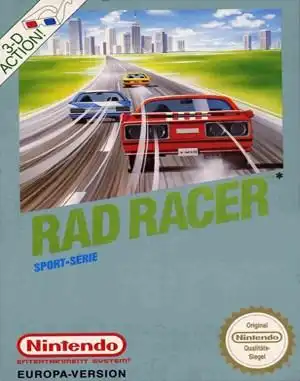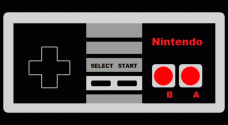Cruising down memory lane often involves the pixelated highways of our favorite retro games. For many NES enthusiasts, that road trip led straight to Rad Racer. Released by Square (yes, that Square, before they were Enix's partner and known for RPGs!), this 1987 title brought arcade-style racing action home, complete with a unique gimmick that blew some minds back in the day.
More than just another racing game, Rad Racer holds a special place for its attempt at pushing graphical boundaries and its unexpected cameos in pop culture and competitive gaming history. Let's put the pedal to the metal and revisit this classic.
What Exactly Was Rad Racer?
At its core, Rad Racer is a sprite-based, third-person perspective racing game for the Nintendo Entertainment System. Developed by Square and originally known as Highway Star in Japan, it challenged players to navigate eight distinct stages in a cross-country race against the clock.
You got to pick between a snazzy red Ferrari 328 or a sleek blue Formula 1 car – though, let's be honest, they handled pretty much identically. The goal was simple: reach the checkpoint before the timer hits zero, all while dodging slower traffic and mastering increasingly tricky turns. Crash into something, and you'd spin out, losing precious seconds.
Hitting the Gas: Gameplay & Mechanics
The gameplay loop in Rad Racer is straightforward but addictive. You accelerate, brake, and steer. Simple, right? Well, the NES D-pad offered a somewhat tight steering experience, which could be frustrating during high-speed maneuvers.
Key mechanics included:
- Turbo Boost: Hit the 'B' button for a temporary burst of speed. Essential for making up time or passing stubborn opponents.
- Checkpoints: The lifeblood of the game. Reaching them extended your race time, allowing you to continue to the next stage.
- Traffic & Obstacles: Other cars and roadside objects were your main hazards. Collisions were frequent and punishing.
- Music Select: A cool feature for the time, letting you cycle between a couple of catchy tunes mid-race using the 'Start' button.
While some critics found the gameplay a bit repetitive compared to arcade giants like Out Run, Rad Racer delivered a solid sense of speed for an 8-bit console and provided a genuine challenge that required practice and precise timing.
The 3D Effect: Gimmick or Game Changer?
Perhaps the most talked-about feature of Rad Racer was its optional stereoscopic 3D mode. By pressing the 'Select' button and donning a pair of red and cyan (anaglyph) glasses, the game attempted to create a sense of depth.
This feature was largely a showcase for programmer Nasir Gebelli's skill with 3D programming on the NES hardware. While it was a novel idea and impressive for the era, the effect was often described as flickering or imperfect. Most players probably experienced Rad Racer in glorious 2D, but the 3D option remains a quirky, memorable part of its identity.
Behind the Wheel: Development & Legacy
Rad Racer wasn't just a random racing game; it had some interesting connections. It was one of Square's early hits on the NES, selling nearly 2 million copies. Its success, alongside other titles, helped keep Square afloat during a financially challenging period, paving the way for a little game you might have heard of called Final Fantasy.
The game also gained significant exposure through two major appearances:
- The Wizard (1989): Rad Racer was prominently featured in this quintessential Nintendo-themed movie, playing a role in the final competition. This cemented its image in the minds of many kids at the time.
- Nintendo World Championship 1990: A special version of Rad Racer was included on the incredibly rare cartridge used for the NWC tournament, alongside Super Mario Bros. and Tetris. Players had to collect coins in a unique Rad Racer level.
A sequel, Rad Racer II, was released later but didn't quite capture the same magic or attention.
Nostalgia Lane: Why We Remember It
Despite its flaws – the sometimes frustrating difficulty, the imperfect 3D, the slightly repetitive track design – Rad Racer is fondly remembered by many retro gamers. It was a common sight in rental stores, a staple of many NES collections.
It offered a thrilling, high-speed experience that felt advanced for its time. The feeling of nailing a perfect turn, hitting the turbo at just the right moment, and squeaking past a checkpoint with seconds to spare created genuine moments of triumph. It represents a specific era of arcade ports and console racers, where simple concepts were pushed to their technical limits.
How to Play Today
Feeling the need for speed? While finding original NES cartridges and a working console is always an option for purists, there are more accessible ways to experience Rad Racer today:
- Emulators: Using NES emulators on PC, Mac, or even modern consoles/devices via platforms like RetroArch allows you to play the game with varying degrees of accuracy.
- Digital Stores: Keep an eye on digital storefronts like the Nintendo eShop on Switch. While Rad Racer isn't always readily available, classic titles do appear. (Note: As of my last update, it's not on NSO, but availability changes).
Dust off your virtual driving gloves and prepare for some classic 8-bit thrills!
Frequently Asked Questions
Q: Was Rad Racer really in 3D? A: Yes, it had an optional stereoscopic 3D mode that required anaglyph (red/cyan) glasses. It was an early attempt at 3D on a console but wasn't true 3D graphics as we know them today.
Q: Is Rad Racer related to Final Fantasy? A: They share the same developer, Square. Rad Racer's commercial success helped provide financial stability for Square during the development of the original Final Fantasy.
Q: How many stages are in Rad Racer? A: There are eight stages in total, taking you across a fictional "Transamerica" race.
Q: Why is the Nintendo World Championship cartridge so rare? A: Only a limited number of these cartridges were produced for the 1990 tournament and subsequent giveaway contests, making them extremely rare and valuable collector's items today.
Whether you first played it in the arcade, on your NES, or saw it in The Wizard, Rad Racer remains a memorable piece of 8-bit racing history. It might not be the most complex or polished racer ever made, but for many, it was their first taste of high-speed thrills on a home console. So, buckle up and enjoy the ride!


